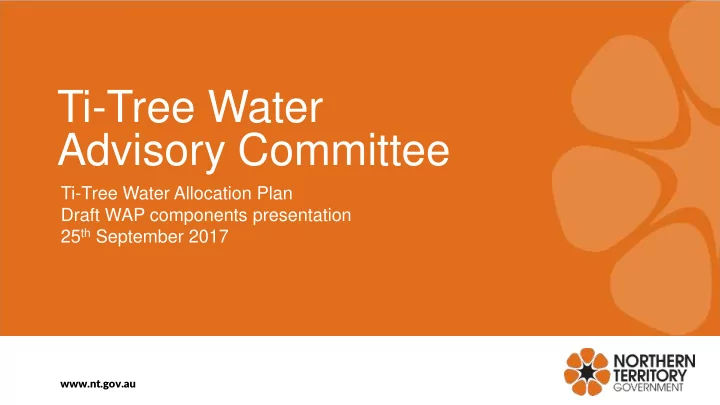

Ti-Tree Water Advisory Committee Ti-Tree Water Allocation Plan Draft WAP components presentation 25 th September 2017 www.nt.gov.au
Ti-Tree WAP objectives 1. Avoid detrimental impacts to water dependent ecosystems as a consequence of consumptive water use 2. Avoid negative impacts to cultural values of places reliant upon surface or groundwater as a consequence of consumptive water use 3. Secure domestic and public water supply for current and future population 4. Provide equitable access to water available for economic activities for current and future generations (beyond 300 years) 5. Enhance opportunities for indigenous people to benefit from consumptive use and management of water
Ti-Tree WAP objectives NT Water Allocation framework All available scientific research directly related to environmental and other public benefit requirements for the water resource will be applied in setting water allocations for non-consumptive use as the first priority, with allocations for consumptive use made subsequently within the remaining available water resource. Aquifers There will be no deleterious change in groundwater discharges to dependent ecosystems, and total extraction over a period of at least 100 years will not exceed 80 % of the total aquifer storage at start of extraction. In the event that current and/ or projected consumptive use exceeds the threshold levels of 80 % of the consumptive pool for aquifers, or groundwater discharges to groundwater dependent ecosystems are impacted, new groundwater Licences will not be granted unless supported by directly related scientific research into groundwater dependent ecosystem/cultural requirements.
WAP Zone options
WAP “natural water balance” Water Quality (TDS Groundwater Groundwater Zone (mg/L)) Storage (GL) Recharge (GL/YR) Central Zone <1000 1601.39 1.09 1000-1500 259.55 0.18 1500-2000 0.00 0.00 2000-4000 0.00 0.00 TOTAL 1860.94 1.26 Eastern Zone <1000 2844.57 1.93 1000-1500 391.82 0.27 1500-2000 242.05 0.16 2000-4000 19.62 0.01 TOTAL 3498.07 2.38 Northern Zone <1000 0.00 0.00 1000-1500 0.00 0.00 1500-2000 135.79 0.09 2000-4000 290.86 0.20 >4000 231.89 0.16 TOTAL 658.55 0.45 Western Zone <1000 17.43 0.01 1000-1500 1086.29 0.74 1500-2000 0.00 0.00 2000-4000 0.00 0.00 TOTAL 1103.71 0.75 Aquifer Total TOTAL 7121.26 4.84 Non-Aquifer Zone <1000 47.81 9.08 1000-1500 31.11 5.91 1500-2000 7.53 1.43 2000-4000 10.59 2.01 >4000 2.13 0.40 TOTAL 99.17 18.84 Grand Total TOTAL 7220.43 23.68
Estimated Sustainable Yield Definition: “The level of water extraction from a particular system which, if exceeded would compromise key environmental assets, or ecosystem functions and the productive base of the resource.” (Source: NWI definition for ‘environmentally sustainable level of extraction’) www.nt.gov.au
Estimated Sustainable Yield Options for how ESY is represented in the Ti-Tree WAP: a) Recharge only b) Recharge + 10% depletion of storage over 300 years c) Recharge + 30% depletion of storage over 300 years d) Recharge + 50% depletion of storage over 300 years e) Recharge + 80% depletion of storage over 300 years Option a) is theoretically available for consumptive use in perpetuity Options b) to e) are allowable for the next 300 years (2017 – 2317). At this point regional groundwater levels would be expected to draw down to their allowable limit.
Estimated Sustainable Yield Option B Option C Option D Option E Option A Recharge Recharge + Recharge + Recharge + Recharge + Management storage storage storage storage zone depletion (10% depletion (30% depletion (50% depletion (80% over 300 over 300 over 300 over 300 years) years) years) years) Western 0.75 1.12 1.85 2.59 3.69 Central 1.26 1.88 3.13 4.37 6.23 Eastern 2.38 3.54 5.87 8.21 11.70 Northern 0.45 0.67 1.11 1.54 2.20 Aquifer Total 4.84 7.21 11.96 16.71 23.83 Non-Aquifer 18.84 18.87 18.94 19.01 19.11 Slightly conservative (could increase)
Estimated Sustainable Yield Vs Current Licensed Use Option A Option B Option C Option D Option E Management Recharge 2009 WAP Current Recharge + Recharge + Recharge + Recharge + zone Allocations Licensed 10% storage 30% storage 50% storage 80% storage depletion depletion depletion depletion Western 0.75 1.12 1.85 2.59 3.69 3.28 2.27 Central 1.26 1.88 3.13 4.37 6.23 7.12 3.00 Eastern 2.38 3.54 5.87 8.21 11.70 3.2 2.10 Northern 0.45 0.67 1.11 1.54 2.20 0.05 0.04 Aquifer Total 4.84 7.21 11.96 16.71 23.83 13.65 7.41 Non-Aquifer 18.84 18.87 18.94 19.01 19.11 0 0
Estimated Sustainable Yield Vs Current Licensed Use What if we combined the zones? Option A Option B Option C Option D Option E Recharge Management 2009 WAP Current Recharge + Recharge + Recharge + Recharge + zone Allocations Licensed 10% storage 30% storage 50% storage 80% storage depletion depletion depletion depletion Western Central Eastern 4.39 6.54 10.85 15.16 21.62 13.6 7.37 Northern 0.45 0.67 1.11 1.54 2.20 0.05 0.04 Aquifer Total 4.84 7.21 11.96 16.71 23.83 13.65 7.41 Non-Aquifer 18.84 18.87 18.94 19.01 19.11 0 0
Estimated Sustainable Yield Discussion questions Q. Which ESY scenario (or other scenario) is appropriate? Why? Q. Should the zones be changed? How?
Water licensing decisions 1. Avoid detrimental impacts to water dependent ecosystems as a consequence of consumptive water use 2. Avoid negative impacts to cultural values of places reliant upon surface or groundwater as a consequence of consumptive water use How do we safeguard cultural and environmental values (e.g. GDEs?) Q. What ‘rules’ should be in place to guide water licencing decisions to achieve the objectives? Q. What conditions should be on licences?
Recommend
More recommend